what orbitals are used to form each bond in methanol
Chapter viii. Advanced Theories of Covalent Bonding
8.2 Hybrid Atomic Orbitals
Learning Objectives
Past the cease of this section, y'all volition exist able to:
- Explicate the concept of atomic orbital hybridization
- Determine the hybrid orbitals associated with various molecular geometries
Thinking in terms of overlapping atomic orbitals is ane fashion for us to explain how chemical bonds class in diatomic molecules. However, to empathize how molecules with more than ii atoms class stable bonds, we require a more detailed model. Equally an case, permit us consider the water molecule, in which we accept one oxygen atom bonding to two hydrogen atoms. Oxygen has the electron configuration 1s 22due south ii2p 4, with two unpaired electrons (one in each of the ii twop orbitals). Valence bond theory would predict that the two O–H bonds form from the overlap of these ii 2p orbitals with the 1s orbitals of the hydrogen atoms. If this were the case, the bond angle would be 90°, as shown in Effigy 1, because p orbitals are perpendicular to each other. Experimental evidence shows that the bond angle is 104.v°, not 90°. The prediction of the valence bond theory model does not lucifer the real-world observations of a h2o molecule; a different model is needed.
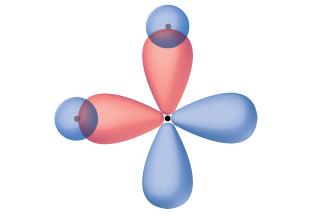
Quantum-mechanical calculations suggest why the observed bond angles in HtwoO differ from those predicted by the overlap of the 1s orbital of the hydrogen atoms with the iip orbitals of the oxygen atom. The mathematical expression known as the wave role, ψ, contains data near each orbital and the wavelike properties of electrons in an isolated atom. When atoms are bound together in a molecule, the moving ridge functions combine to produce new mathematical descriptions that have dissimilar shapes. This procedure of combining the wave functions for atomic orbitals is called hybridization and is mathematically achieved by the linear combination of atomic orbitals, LCAO, (a technique that nosotros will run into over again subsequently). The new orbitals that result are called hybrid orbitals. The valence orbitals in an isolated oxygen atom are a 2due south orbital and 3 2p orbitals. The valence orbitals in an oxygen atom in a water molecule differ; they consist of 4 equivalent hybrid orbitals that point approximately toward the corners of a tetrahedron (Figure ii). Consequently, the overlap of the O and H orbitals should result in a tetrahedral bond angle (109.5°). The observed bending of 104.five° is experimental evidence for which quantum-mechanical calculations give a useful explanation: Valence bond theory must include a hybridization component to give accurate predictions.

The following ideas are important in understanding hybridization:
- Hybrid orbitals do not exist in isolated atoms. They are formed simply in covalently bonded atoms.
- Hybrid orbitals have shapes and orientations that are very unlike from those of the diminutive orbitals in isolated atoms.
- A set up of hybrid orbitals is generated past combining atomic orbitals. The number of hybrid orbitals in a set is equal to the number of diminutive orbitals that were combined to produce the gear up.
- All orbitals in a ready of hybrid orbitals are equivalent in shape and free energy.
- The type of hybrid orbitals formed in a bonded atom depends on its electron-pair geometry every bit predicted by the VSEPR theory.
- Hybrid orbitals overlap to form σ bonds. Unhybridized orbitals overlap to class π bonds.
In the post-obit sections, we shall discuss the common types of hybrid orbitals.
sp Hybridization
The beryllium cantlet in a gaseous BeCltwo molecule is an example of a primal atom with no lonely pairs of electrons in a linear system of three atoms. There are two regions of valence electron density in the BeCl2 molecule that correspond to the two covalent Be–Cl bonds. To arrange these ii electron domains, two of the Be atom'due south four valence orbitals will mix to yield ii hybrid orbitals. This hybridization process involves mixing of the valence s orbital with one of the valence p orbitals to yield 2 equivalent sp hybrid orbitals that are oriented in a linear geometry (Figure iii). In this figure, the set of sp orbitals appears similar in shape to the original p orbital, only there is an important difference. The number of diminutive orbitals combined e'er equals the number of hybrid orbitals formed. The p orbital is one orbital that can hold upward to two electrons. The sp set is two equivalent orbitals that point 180° from each other. The two electrons that were originally in the southward orbital are at present distributed to the two sp orbitals, which are half filled. In gaseous BeCl2, these half-filled hybrid orbitals will overlap with orbitals from the chlorine atoms to form ii identical σ bonds.

Nosotros illustrate the electronic differences in an isolated Be atom and in the bonded Be atom in the orbital free energy-level diagram in Effigy 4. These diagrams represent each orbital by a horizontal line (indicating its energy) and each electron past an arrow. Energy increases toward the top of the diagram. We employ one upwardly arrow to indicate one electron in an orbital and two arrows (upward and down) to indicate two electrons of reverse spin.

When atomic orbitals hybridize, the valence electrons occupy the newly created orbitals. The Be atom had two valence electrons, so each of the sp orbitals gets ane of these electrons. Each of these electrons pairs up with the unpaired electron on a chlorine atom when a hybrid orbital and a chlorine orbital overlap during the formation of the Be–Cl bonds.
Any central atom surrounded by only ii regions of valence electron density in a molecule will exhibit sp hybridization. Other examples include the mercury atom in the linear HgCl2 molecule, the zinc cantlet in Zn(CH3)2, which contains a linear C–Zn–C arrangement, and the carbon atoms in HCCH and CO2.

Check out the University of Wisconsin-Oshkosh website to learn about visualizing hybrid orbitals in three dimensions.
sp 2 Hybridization
The valence orbitals of a central atom surrounded by three regions of electron density consist of a set of three sp two hybrid orbitals and 1 unhybridized p orbital. This arrangement results from sp 2 hybridization, the mixing of i due south orbital and 2 p orbitals to produce three identical hybrid orbitals oriented in a trigonal planar geometry (Figure 5).
Although breakthrough mechanics yields the "plump" orbital lobes equally depicted in Figure 5, sometimes for clarity these orbitals are drawn thinner and without the minor lobes, as in Figure 6, to avert obscuring other features of a given illustration. We will use these "thinner" representations whenever the true view is likewise crowded to easily visualize.
The observed structure of the borane molecule, BHthree, suggests sp 2 hybridization for boron in this chemical compound. The molecule is trigonal planar, and the boron cantlet is involved in 3 bonds to hydrogen atoms (Figure 7). We can illustrate the comparison of orbitals and electron distribution in an isolated boron cantlet and in the bonded atom in BHiii equally shown in the orbital energy level diagram in Figure eight. We redistribute the three valence electrons of the boron atom in the three sp two hybrid orbitals, and each boron electron pairs with a hydrogen electron when B–H bonds form.

Any central cantlet surrounded by iii regions of electron density will exhibit sp 2 hybridization. This includes molecules with a alone pair on the central atom, such as ClNO (Figure 9), or molecules with two unmarried bonds and a double bond connected to the central atom, every bit in formaldehyde, CH2O, and ethene, H2CCHii.

sp iii Hybridization
The valence orbitals of an atom surrounded by a tetrahedral system of bonding pairs and lonely pairs consist of a set of four sp 3 hybrid orbitals. The hybrids consequence from the mixing of one s orbital and all three p orbitals that produces four identical sp 3 hybrid orbitals (Figure 10). Each of these hybrid orbitals points toward a different corner of a tetrahedron.
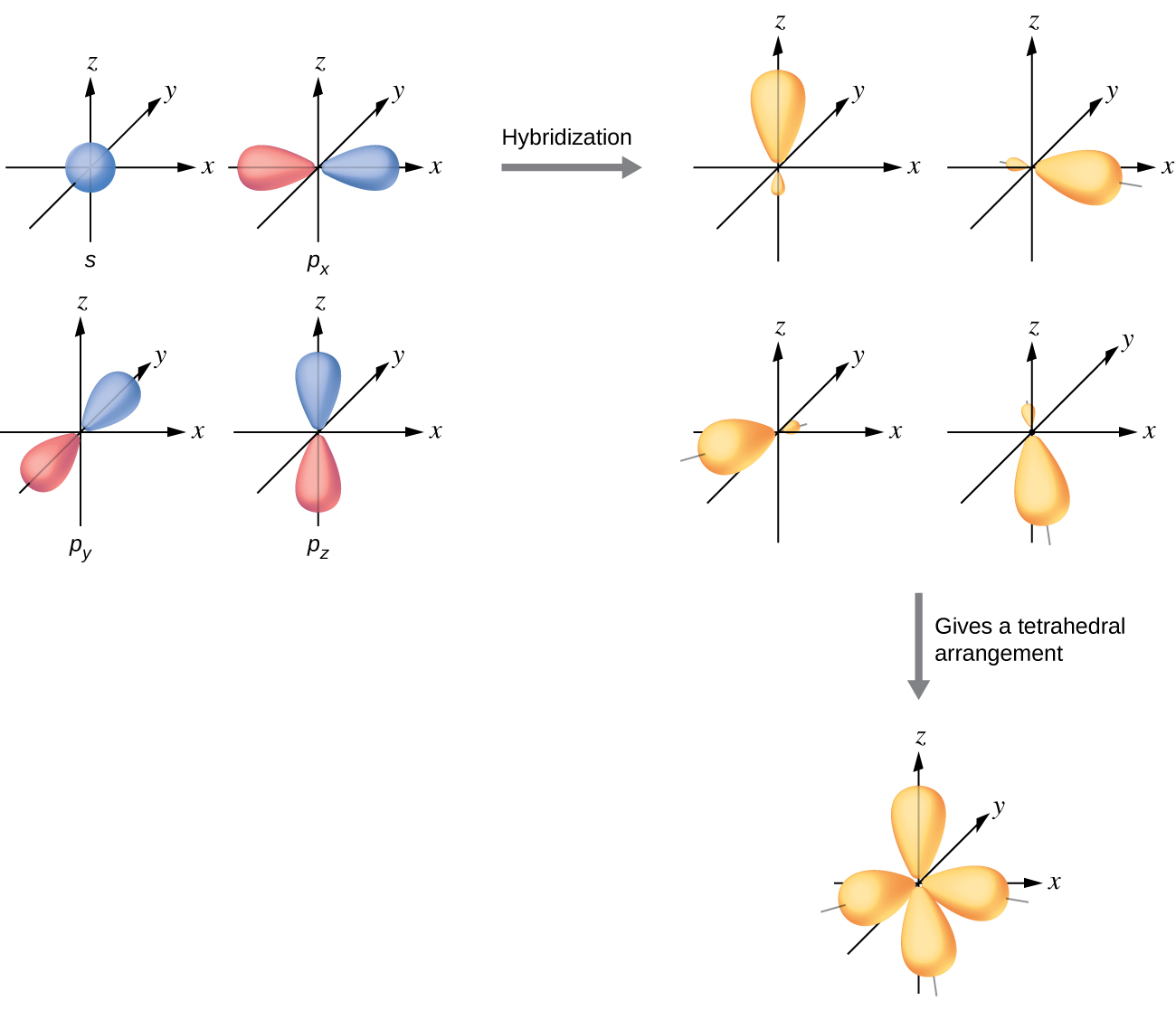
A molecule of marsh gas, CH4, consists of a carbon atom surrounded by iv hydrogen atoms at the corners of a tetrahedron. The carbon atom in methane exhibits sp 3 hybridization. Nosotros illustrate the orbitals and electron distribution in an isolated carbon atom and in the bonded atom in CHfour in Figure 11. The four valence electrons of the carbon atom are distributed equally in the hybrid orbitals, and each carbon electron pairs with a hydrogen electron when the C–H bonds form.

In a methyl hydride molecule, the 1s orbital of each of the four hydrogen atoms overlaps with 1 of the four sp 3 orbitals of the carbon atom to class a sigma (σ) bond. This results in the formation of four strong, equivalent covalent bonds between the carbon atom and each of the hydrogen atoms to produce the methane molecule, CHiv.
The construction of ethane, CiiH6, is like to that of methane in that each carbon in ethane has four neighboring atoms bundled at the corners of a tetrahedron—3 hydrogen atoms and one carbon atom (Effigy 12). However, in ethane an sp 3 orbital of 1 carbon atom overlaps end to cease with an sp 3 orbital of a second carbon atom to form a σ bond between the 2 carbon atoms. Each of the remaining sp 3 hybrid orbitals overlaps with an s orbital of a hydrogen atom to class carbon–hydrogen σ bonds. The structure and overall outline of the bonding orbitals of ethane are shown in Figure 12. The orientation of the two CH3 groups is not fixed relative to each other. Experimental evidence shows that rotation around σ bonds occurs easily.

An sp three hybrid orbital can as well hold a alone pair of electrons. For example, the nitrogen atom in ammonia is surrounded by 3 bonding pairs and a lone pair of electrons directed to the iv corners of a tetrahedron. The nitrogen atom is sp 3 hybridized with 1 hybrid orbital occupied by the lone pair.
The molecular structure of h2o is consistent with a tetrahedral arrangement of 2 solitary pairs and 2 bonding pairs of electrons. Thus nosotros say that the oxygen atom is sp 3 hybridized, with two of the hybrid orbitals occupied by lonely pairs and two by bonding pairs. Since lone pairs occupy more space than bonding pairs, structures that comprise lone pairs have bail angles slightly distorted from the ideal. Perfect tetrahedra have angles of 109.5°, but the observed angles in ammonia (107.iii°) and water (104.5°) are slightly smaller. Other examples of sp three hybridization include CCl4, PCliii, and NCl3.
sp iii d and sp 3 d 2 Hybridization
To draw the 5 bonding orbitals in a trigonal bipyramidal arrangement, we must use five of the valence shell atomic orbitals (the s orbital, the three p orbitals, and i of the d orbitals), which gives five sp 3 d hybrid orbitals. With an octahedral organisation of vi hybrid orbitals, we must use 6 valence shell atomic orbitals (the south orbital, the three p orbitals, and two of the d orbitals in its valence beat), which gives six sp 3 d two hybrid orbitals. These hybridizations are merely possible for atoms that have d orbitals in their valence subshells (that is, not those in the commencement or second period).
In a molecule of phosphorus pentachloride, PCl5, at that place are five P–Cl bonds (thus five pairs of valence electrons effectually the phosphorus atom) directed toward the corners of a trigonal bipyramid. We use the 3southward orbital, the three 3p orbitals, and one of the 3d orbitals to form the set of 5 sp iii d hybrid orbitals (Effigy 14) that are involved in the P–Cl bonds. Other atoms that exhibit sp 3 d hybridization include the sulfur atom in SFfour and the chlorine atoms in ClFthree and in ClF4 +. (The electrons on fluorine atoms are omitted for clarity.)

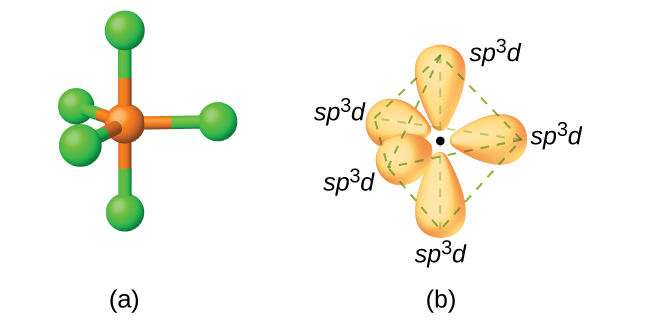
The sulfur atom in sulfur hexafluoride, SF6, exhibits sp three d ii hybridization. A molecule of sulfur hexafluoride has vi bonding pairs of electrons connecting six fluorine atoms to a single sulfur atom. There are no lone pairs of electrons on the central atom. To bond half-dozen fluorine atoms, the 3s orbital, the three 3p orbitals, and 2 of the iiid orbitals form six equivalent sp 3 d 2 hybrid orbitals, each directed toward a unlike corner of an octahedron. Other atoms that exhibit sp 3 d 2 hybridization include the phosphorus atom in PClhalf-dozen −, the iodine atom in the interhalogens IFhalf dozen +, IF5, ICl4 −, IFiv − and the xenon cantlet in XeF4.
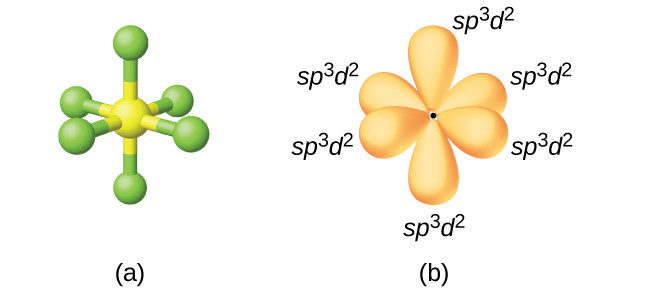
Consignment of Hybrid Orbitals to Central Atoms
The hybridization of an cantlet is determined based on the number of regions of electron density that surround information technology. The geometrical arrangements characteristic of the various sets of hybrid orbitals are shown in Figure 16. These arrangements are identical to those of the electron-pair geometries predicted by VSEPR theory. VSEPR theory predicts the shapes of molecules, and hybrid orbital theory provides an explanation for how those shapes are formed. To detect the hybridization of a fundamental atom, nosotros can utilize the following guidelines:
- Determine the Lewis structure of the molecule.
- Make up one's mind the number of regions of electron density effectually an atom using VSEPR theory, in which single bonds, multiple bonds, radicals, and lone pairs each count as one region.
- Assign the set of hybridized orbitals from Figure 16 that corresponds to this geometry.

Information technology is important to remember that hybridization was devised to rationalize experimentally observed molecular geometries. The model works well for molecules containing modest central atoms, in which the valence electron pairs are close together in space. Yet, for larger central atoms, the valence-shell electron pairs are farther from the nucleus, and there are fewer repulsions. Their compounds exhibit structures that are often not consistent with VSEPR theory, and hybridized orbitals are not necessary to explicate the observed data. For example, we have discussed the H–O–H bond angle in H2O, 104.5°, which is more than consistent with sp 3 hybrid orbitals (109.5°) on the central cantlet than with iip orbitals (90°). Sulfur is in the same group as oxygen, and H2Due south has a similar Lewis construction. All the same, it has a much smaller bond angle (92.one°), which indicates much less hybridization on sulfur than oxygen. Continuing downwardly the group, tellurium is even larger than sulfur, and for H2Te, the observed bond angle (90°) is consistent with overlap of the 5p orbitals, without invoking hybridization. Nosotros invoke hybridization where it is necessary to explain the observed structures.

Example one
Assigning Hybridization
Ammonium sulfate is important equally a fertilizer. What is the hybridization of the sulfur atom in the sulfate ion, SO4 two−?
Solution
The Lewis structure of sulfate shows there are four regions of electron density. The hybridization is sp three.
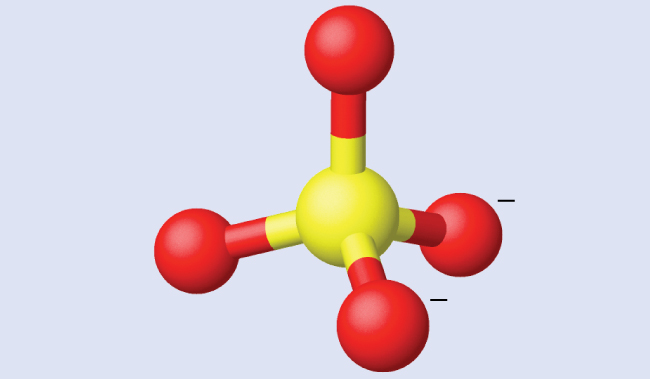
Check Your Learning
What is the hybridization of the selenium cantlet in SeF4?
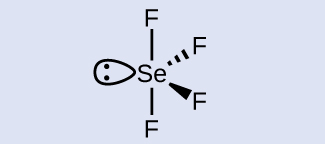
Answer:
The selenium cantlet is sp iii d hybridized.
Example 2
Assigning Hybridization
Urea, NHiiC(O)NH2, is sometimes used as a source of nitrogen in fertilizers. What is the hybridization of each nitrogen and carbon atom in urea?
Solution
The Lewis construction of urea is
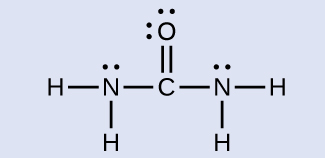
The nitrogen atoms are surrounded past 4 regions of electron density, which adjust themselves in a tetrahedral electron-pair geometry. The hybridization in a tetrahedral organisation is sp 3 (Figure 16). This is the hybridization of the nitrogen atoms in urea.
The carbon atom is surrounded by 3 regions of electron density, positioned in a trigonal planar arrangement. The hybridization in a trigonal planar electron pair geometry is sp 2 (Effigy 16), which is the hybridization of the carbon atom in urea.
Cheque Your Learning
Acetic acid, H3CC(O)OH, is the molecule that gives vinegar its odor and sour taste. What is the hybridization of the 2 carbon atoms in acerb acid?
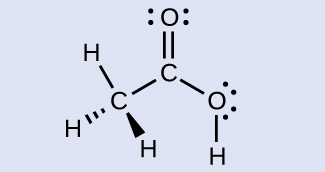
Answer:
H3 C, sp 3; C(O)OH, sp ii
Primal Concepts and Summary
We can use hybrid orbitals, which are mathematical combinations of some or all of the valence atomic orbitals, to describe the electron density around covalently bonded atoms. These hybrid orbitals either class sigma (σ) bonds directed toward other atoms of the molecule or contain alone pairs of electrons. We can determine the type of hybridization around a fundamental atom from the geometry of the regions of electron density nearly information technology. Two such regions imply sp hybridization; three, sp two hybridization; four, sp three hybridization; 5, sp 3 d hybridization; and half-dozen, sp 3 d 2 hybridization. Pi (π) bonds are formed from unhybridized diminutive orbitals (p or d orbitals).
Chemistry End of Chapter Exercises
- Why is the concept of hybridization required in valence bond theory?
- Give the shape that describes each hybrid orbital gear up:
(a) sp 2
(b) sp three d
(c) sp
(d) sp 3 d 2
- Explain why a carbon atom cannot grade v bonds using sp 3 d hybrid orbitals.
- What is the hybridization of the fundamental atom in each of the post-obit?
(a) BeH2
(b) SF6
(c) PO4 iii−
(d) PCl5
- A molecule with the formula AB3 could take one of four different shapes. Give the shape and the hybridization of the central A atom for each.
- Methionine, CH3SCH2CH2CH(NHtwo)CO2H, is an amino acrid constitute in proteins. Depict a Lewis structure of this compound. What is the hybridization type of each carbon, oxygen, the nitrogen, and the sulfur?
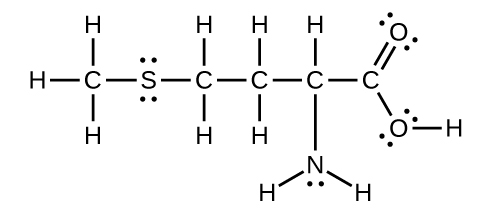
- Sulfuric acid is manufactured past a serial of reactions represented by the post-obit equations:[latex]\text{Due south}_8(s) + 8 \text{O}_2(grand) \longrightarrow 8\text{SO}_2(chiliad)[/latex]
[latex]2\text{SO}_2(1000) + \text{O}_2(g) \longrightarrow 2\text{And then}_3(g)[/latex]
[latex]\text{And then}_3(g) + \text{H}_2 \text{O}(50) \longrightarrow \text{H}_2 \text{So}_4(l)[/latex]Draw a Lewis structure, predict the molecular geometry by VSEPR, and determine the hybridization of sulfur for the following:
(a) circular Due south8 molecule
(b) And so2 molecule
(c) SO3 molecule
(d) HtwoSO4 molecule (the hydrogen atoms are bonded to oxygen atoms)
- Ii important industrial chemicals, ethene, C2H4, and propene, CiiiH6, are produced by the steam (or thermal) swell process:
[latex]ii\text{C}_3 \text{H}_8(g) \longrightarrow \text{C}_2\text{H}_4(thousand) + \text{C}_3\text{H}_6(grand) + \text{CH}_4(g) + \text{H}_2(grand)[/latex]
For each of the 4 carbon compounds, do the following:
(a) Draw a Lewis structure.
(b) Predict the geometry about the carbon atom.
(c) Determine the hybridization of each type of carbon cantlet.
- For many years after they were discovered, information technology was believed that the noble gases could not grade compounds. At present we know that belief to be incorrect. A mixture of xenon and fluorine gases, confined in a quartz bulb and placed on a windowsill, is found to slowly produce a white solid. Analysis of the chemical compound indicates that it contains 77.55% Xe and 22.45% F by mass.
(a) What is the formula of the compound?
(b) Write a Lewis construction for the compound.
(c) Predict the shape of the molecules of the compound.
(d) What hybridization is consequent with the shape you predicted?
- Consider nitrous acid, HNO2 (HONO).
(a) Write a Lewis structure.
(b) What are the electron pair and molecular geometries of the internal oxygen and nitrogen atoms in the HNOtwo molecule?
(c) What is the hybridization on the internal oxygen and nitrogen atoms in HNO2?
- Strike-anywhere matches contain a layer of KClO3 and a layer of P4S3. The heat produced past the friction of striking the lucifer causes these two compounds to react vigorously, which sets fire to the wooden stem of the match. KClO3 contains the ClOiii − ion. PfourSthree is an unusual molecule with the skeletal construction.
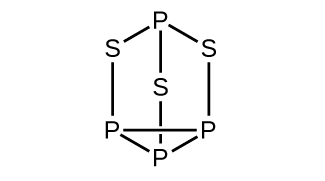
(a) Write Lewis structures for PivS3 and the ClOthree – ion.
(b) Describe the geometry about the P atoms, the S atom, and the Cl atom in these species.
(c) Assign a hybridization to the P atoms, the S atom, and the Cl atom in these species.
(d) Determine the oxidation states and formal accuse of the atoms in P4Siii and the ClO3 – ion.
- Identify the hybridization of each carbon cantlet in the post-obit molecule. (The arrangement of atoms is given; you need to determine how many bonds connect each pair of atoms.)

- Write Lewis structures for NFiii and PF5. On the footing of hybrid orbitals, explain the fact that NFiii, PFiii, and PF5 are stable molecules, but NFfive does non exist.
- In addition to NF3, ii other fluoro derivatives of nitrogen are known: NorthtwoFiv and N2Ftwo. What shapes practise you predict for these two molecules? What is the hybridization for the nitrogen in each molecule?
Glossary
- hybrid orbital
- orbital created by combining atomic orbitals on a central atom
- hybridization
- model that describes the changes in the atomic orbitals of an atom when information technology forms a covalent compound
- sp hybrid orbital
- one of a set of ii orbitals with a linear organisation that results from combining ane s and one p orbital
- sp two hybrid orbital
- one of a set of three orbitals with a trigonal planar arrangement that results from combining one s and 2 p orbitals
- sp 3 hybrid orbital
- ane of a gear up of iv orbitals with a tetrahedral organization that results from combining one due south and three p orbitals
- sp iii d hybrid orbital
- ane of a set of five orbitals with a trigonal bipyramidal organisation that results from combining one southward, 3 p, and one d orbital
- sp 3 d 2 hybrid orbital
- one of a fix of six orbitals with an octahedral arrangement that results from combining ane s, iii p, and two d orbitals
Solutions
Answers to Chemistry End of Chapter Exercises
ane. Hybridization is introduced to explain the geometry of bonding orbitals in valance bond theory.
3. There are no d orbitals in the valence shell of carbon.
5. trigonal planar, sp 2; trigonal pyramidal (ane lone pair on A) sp 3; T-shaped (two lone pairs on A sp 3 d, or (three solitary pairs on A) sp 3 d 2
vii. (a) Each S has a bent (109°) geometry, sp 3
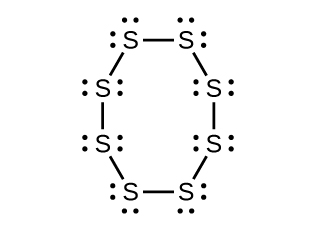
(b) Aptitude (120°), sp 2

(c) Trigonal planar, sp 2

(d) Tetrahedral, sp 3
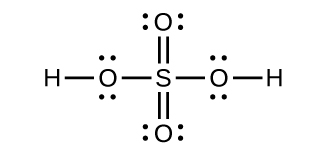
9. a) XeFtwo
(b)

(c) linear (d) sp 3 d
11. (a)

(b) P atoms, trigonal pyramidal; Southward atoms, bent, with ii lone pairs; Cl atoms, trigonal pyramidal; (c) Hybridization almost P, Southward, and Cl is, in all cases, sp 3; (d) Oxidation states P +1, [latex]\text{S} - 1\frac{1}{3}[/latex], Cl +five, O –two. Formal charges: P 0; S 0; Cl +two: O –1
13. 
Phosphorus and nitrogen tin can form sp 3 hybrids to form iii bonds and hold i alone pair in PF3 and NF3, respectively. However, nitrogen has no valence d orbitals, so information technology cannot form a ready of sp iii d hybrid orbitals to demark 5 fluorine atoms in NF5. Phosphorus has d orbitals and can bind five fluorine atoms with sp three d hybrid orbitals in PF5.
cummingssherted76.blogspot.com
Source: https://opentextbc.ca/chemistry/chapter/8-2-hybrid-atomic-orbitals/
0 Response to "what orbitals are used to form each bond in methanol"
Post a Comment